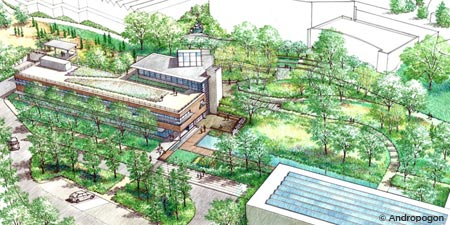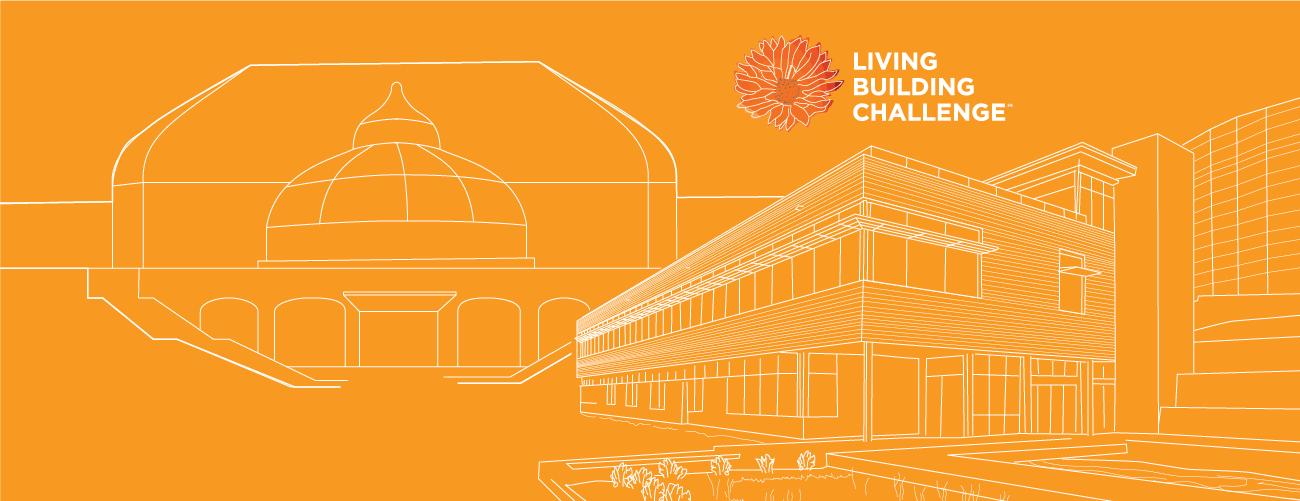Phipps Conservatory and Botanical Gardens
 Following the best available environmental practices is part of the mission of Phipps Conservatory and Botanical Gardens. The Conservatory, a regional treasure, has taken a national leadership role in the environmental design of its facilities with the completion of what is likely the most energy-efficient greenhouse in the world. evolveEA is working closely with Phipps to extend its visionary efforts by assisting in the greening of existing buildings (including the iconic 1893 glass house) and with the design and construction of the Phipps Center for Sustainable Landscapes. This is an unprecedented net-zero energy water and waste building and pilot project for the Living Building Challenge rating system.
Following the best available environmental practices is part of the mission of Phipps Conservatory and Botanical Gardens. The Conservatory, a regional treasure, has taken a national leadership role in the environmental design of its facilities with the completion of what is likely the most energy-efficient greenhouse in the world. evolveEA is working closely with Phipps to extend its visionary efforts by assisting in the greening of existing buildings (including the iconic 1893 glass house) and with the design and construction of the Phipps Center for Sustainable Landscapes. This is an unprecedented net-zero energy water and waste building and pilot project for the Living Building Challenge rating system.
Buildings in Operation
On the Phipps campus, evolveEA managed the LEED EBOM (LEED for Existing Building Operations and Maintenance) process to achieve operational performance goals such as reducing energy usage, installation of appropriate measurement and verification submetering equipment, identification of opportunities to improve efficiency, re-organizing and re-systematizing Phipps Green Team initiatives, improving organizational procurement practices, and optimizing waste reduction strategies.
The Phipps Production Greenhouse earned LEED for Existing Buildings Operations and Maintenance Platinum Certification; illustrating the potential for our existing buildings to play an important role in reducing environmental impacts. The Platinum rating, USGBC’s highest, is notable because the conservatory has become a member of an elite group of buildings across the country. The Conservatory is also the first botanical garden in the nation to use LEED-EBOM to comprehensively improve the building’s Operations and Maintenance.
The Certification represents the culmination of a multi-year effort to fully integrate sustainable operations within the Phipps organization. The campus in Schenley park contains some of the most technologically advanced green building systems, tools to monitor them, and comprehensive green operations and maintenance practices in the region. As part of this effort, evolveEA guided the project team to:
- Conduct a historical and peer group energy benchmarking study to better understand the relative efficiency and unique operating characteristics found across the country’s greenhouses.
- Install campus-wide energy and water monitoring equipment which allows for real-time monitoring of resource usage in each campus building,
- Commission and audit all of the buildings on campus to ensure they were operating efficiently and effectively, and
- Instill organizational goals geared toward achieving a zero waste and environmentally sensitive campus and culture.
As a result:
- The stormwater falling on the production greenhouse is used as a water source for the CSL
- The campus now closely monitors and adjusts irrigation to minimize impacts during dry spells
- The Production Greenhouse operates 33% more efficiently than other similar glass production greenhouses
- Auditing, monitoring, and automatic controls ensure the Production Greenhouse is optimally heated and cooled, and can take advantage of natural ventilation
- Phipps Conservatory recycles over 80% of all waste generated on campus
- Phipps utilizes integrated pest management best practices to ensure harmful chemicals are used sparingly if at all.
Sustainable Strategies

Since early 2007, evolveEA assisted with the Center for Sustainable Landscapes (CSL) project by collaboratively developing a Project Statement that helped define the project issues, parameters, and process. evolveEA then led and assisted the project team selection process, and have been an active part of the project since its inception.
Phipps opened the 24,500 sf Center for Sustainable Landscapes in 2012. In its pursuit of becoming the conservatory with the world’s highest green standards, this new building was designed and built with the goal of receiving a Living Building Challenge certification, a LEED Platinum certification, and a four-star certification in the new SITES landscape rating system. The design treats stormwater in a lagoon, treats sewage in a constructed wetland, has a geothermal well field, extensive photovoltaic arrays, and was designed as a living, net-zero energy building. The entire design and construction team is from Pennsylvania. evolveEA managed the Living Building Challenge certification and the LEED certification process for the project, helping the CSL to achieve the highest possible LEED score for a new construction project with LEED Platinum certification.
The Legacy Continues
 At 10,658 SF, Phipps’ Exhibit Staging Center (ESC) is the newest addition to the pioneering campus. The project achieved LEED v4: BD+C Platinum in addition to WELL v2 Pilot Platinum and Living Building Challenge certifications. evolveEA managed the LEED submission, developed a roadmap to Platinum, and performed QA/QC throughout the design and construction phases.
At 10,658 SF, Phipps’ Exhibit Staging Center (ESC) is the newest addition to the pioneering campus. The project achieved LEED v4: BD+C Platinum in addition to WELL v2 Pilot Platinum and Living Building Challenge certifications. evolveEA managed the LEED submission, developed a roadmap to Platinum, and performed QA/QC throughout the design and construction phases.
The ESC is a former City of Pittsburgh public works building, which has been adapted and modernized into a workspace for Phipps’ facilities maintenance, grounds crew, and flower show production. In addition to space for prop creation, the ESC features a yoga studio, fitness center and meditation room to encourage the mental and physical wellness of employees.
Sustainable strategies for this building include:
- Radiant flooring is used throughout the facility to ensure temperature stability and comfort of building occupants.
- An IAQ station displays both the indoor and outdoor air quality in real-time. Automatic windows open and close depending on the outdoor air quality and indicators on the manual windows ensure occupants are aware of times they can open the windows for fresh air.
- Geothermal wells control radiant flooring which passively heats and cools the building ensuring temperature stability and occupant comfort.
- The ESC is host to an impressive and state-of-the-art photovoltaic system & direct current busway that feeds power generated from the sun directly to the lighting system and battery bank, which can then be stored for later use.
- Free of Red List Materials and therefore avoids many of the toxic chemicals normally found in building materials.


